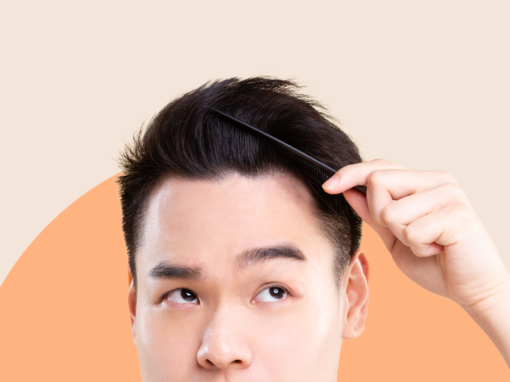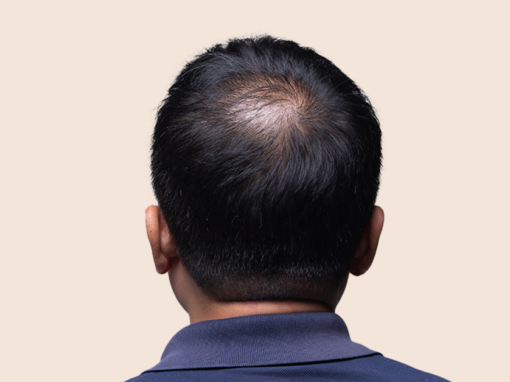Have you recently noticed loose strands of hair on your pillow or the comb? If so, chances are high that this could be an early sign of balding.
Androgenetic alopecia or male pattern baldness happens gradually like all signs of balding. Unfortunately, most men ignore these symptoms until they have lost a significant portion of their hair.
Luckily there are several visible signs to detect a receding hairline, and if you act promptly, you could stop the rate of progress.
This article will discuss some of the vital warning signs to look out for a receding hairline.
The article is a part of our comprehensive series on “Receding hairline in men”
At what age will hairline start to recede in men?
Research has indicated that a receding hairline in men can practically start at any time after puberty.
However, it will be more visible by the time men are around their 30s. The process first starts above the temples and gradually progresses backwards.
What does an early receding hairline look like?
As a receding hairline shows no definite pattern, it is pretty tricky to tell if your hairline is receding or not.
However, one of the easiest ways by which you could try this out is by running your fingers gently through your head to check if any stands come out quickly.
If you have an old photograph of yours, you could compare it with your current one to see if your hairline is receding.
If you are still not satisfied, you can book an appointment with a dermatologist to clear the confusion.
Following are some of the critical warning signs of receding hairline in adults.
1. Excessive hair loss while showering or brushing
If you notice too much hair loss while combing your hair or having a shower, chances are high that you might be experiencing unnatural hair loss.
Studies have shown that people tend to lose 50 to 100 strands of hair in a day. It isn’t a significant matter of concern if this is the case.
Additionally, sometimes you might also be experiencing temporary hair loss, which might happen for a few days or weeks and finally stop. This could be due to a new medication, a stressful life event or other temporary factors.
However, your hair will usually start to grow at a regular rate after a brief hair loss period.

2. Visible changes in your hairline
The most common reason for changes in your hairline is due to genetic factors or hormonal issues.
On average, men will have visible changes in their hairline only during their thirties. After that, your hair will first start to recede above the temples and progress further backwards. This might leave a circular patch without hair.
Sometimes a widow’s peak or M-shaped form will appear on the front side.
3. White patches on nails
Nails often give clues to several things happening to your body. This is the main reason why medical professionals often examine your nails to check for various symptoms.
If you happen to notice white patches, small craters on your nails, it is an indication that your hair health is not good.
4. Hair loss from the crown portion
Hair follicles that are highly sensitive to DHT are located in the crown region of the head. This is the main reason most people experience hair loss at the crown portion.
If you are someone affected by hair loss, you might have noticed hair at the crown region of the head getting thinner.
This is difficult to notice, and most men won’t realise until they have lost 50% of their hair.
On the other hand, hair follicles that are highly resistant to DHT are located in the backside and won’t fall off quite easily.
5. Poor hair growth
This is an obvious and unambiguous indication of a receding hairline. The average rate of hair growth in a healthy scalp for adult men is .3 to .4 mm/day.
If you happen to notice that your hair does not grow well enough after a haircut or grows very slowly, this is a warning sign of a receding hairline.
At a specific time, a random number of hair will be in either of these stages:
- Anagen- Growing stage
- Catagen- Transitional stage
- Telogen- Resting stage
However, unlike popular belief, your head is not the only area that could be affected by hair loss. An autoimmune condition such as alopecia areata causes the body’s immune system to attack the healthy hair follicles resulting in hair loss.
It can cause patches of hair to fall off from your beard, chest, eyelashes or even from the pubic region.
In some instances, the patient loses hair from the entire chest (alopecia Universalis) or head portion(alopecia totalis).
Alopecia areata can be reversed in most cases with proper medication and diet.
7. Sudden loss of patches of hair

If you have noticed itching, burning or stinging sensation before your hair loss, it could be a sign of an infection and should be given immediate medical attention.
References
Sineida Berbert Ferreira,Morton Scheinberg,Denise Steiner,Tatiana Steiner,Gustavo Longhi Bedin and Rachel Berbert Ferreira(5 Dec 2016)Remarkable Improvement of Nail Changes in Alopecia Areata Universalis with 10 Months of Treatment with Tofacitinib: A Case Report, Available at https://www.ncbi.nlm.nih.gov/pmc/articles/PMC5216217/ [Accessed 19 Sep 2021]
Chin H. Ho,Tanuj Sood,Patrick M. Zito(11 August 2021)Androgenetic Alopecia, Available at https://www.ncbi.nlm.nih.gov/books/NBK430924/ [Accessed 19 Sep 2021]


